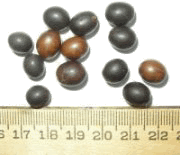 There are a number of ways of getting seeds to germinate, but you’re best off doing that indoors because that’s where the environment is better protected. A seed needs to absorb water before it can germinate. After this imbibing of water, biological processes get to work inside the seed and it comes, as it were, to life.
There are a number of ways of getting seeds to germinate, but you’re best off doing that indoors because that’s where the environment is better protected. A seed needs to absorb water before it can germinate. After this imbibing of water, biological processes get to work inside the seed and it comes, as it were, to life.
When transplanting, place the sprouted now seedlings 2.5 times the seed height under the surface (e.g. If seed is 2mm place 5mm under the surface). Make sure the moisture is sufficiently high, but remember too that the area around the seeds mustn’t be too damp. So go easy on the watering.
When the first real leaves appear on your plants you can start giving some fertilizer. The fertilizer concentration mustn’t be too high: use about one half to two thirds strength fertilizer. Keep the temperature between 20°C and 25°C. Ideal humidity at this stage is between 70% and 90%.
The light spectrum the plant sees also has a considerable influence on the way your plants grow. The blue part of the spectrum is what gets the plants to grow widthways rather than tall. This allows you to get robust plants before they start to flower. We call it vegetative growing (vegging) if you start growing plants in one area or under a different light spectrum before moving them into another area, or changing the light spectrum, to flower. Again, this encourages robust plants that pick up strength faster and that can be readied for flowering straight away. Other advantages include less waste and more frequent harvesting. You normally use fluorescent lighting in the seedling stage. This light is easy and inexpensive and a further advantage is that the lamps can be set close to the plants so you don’t need much room.
Although the plant continues to grow when it comes into bloom, many growers incorporate a vegetative growth phase first. The longer this period lasts, the longer it takes before any harvesting. However, on the other hand, the plant has much more time to develop branches; this increases its resistance to disease and defects, and also provides a bigger crop later. Allowing your plants a least a one week veg phase will make them strong and robust.